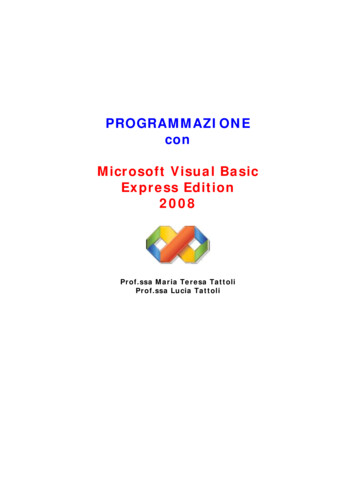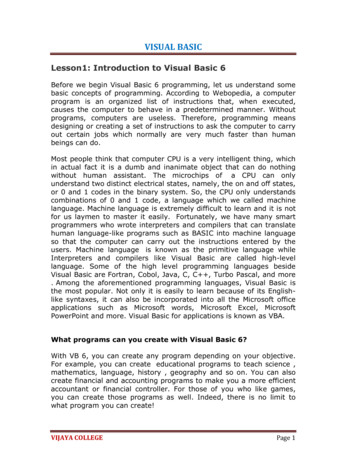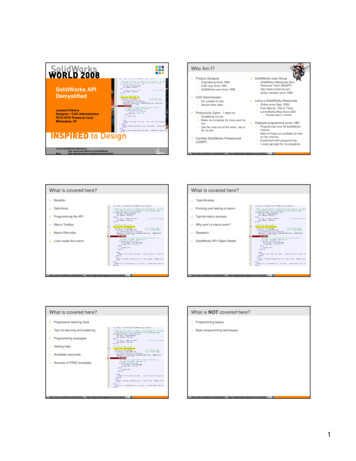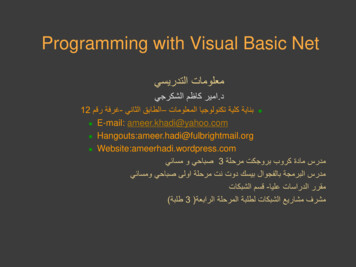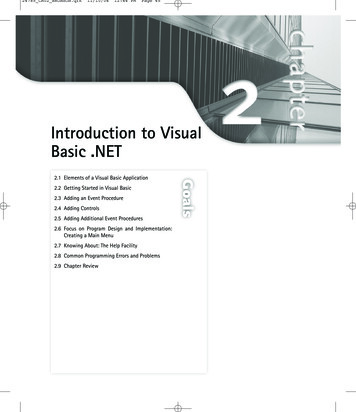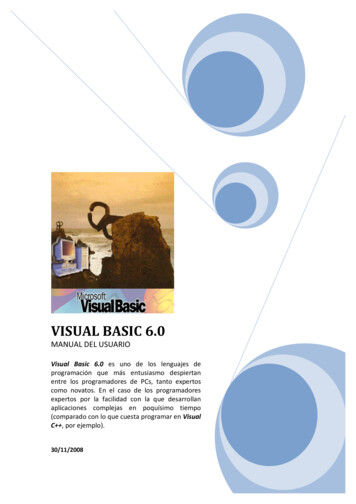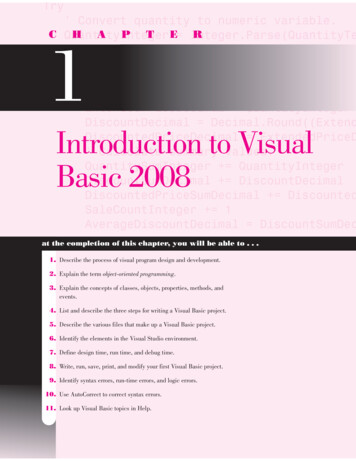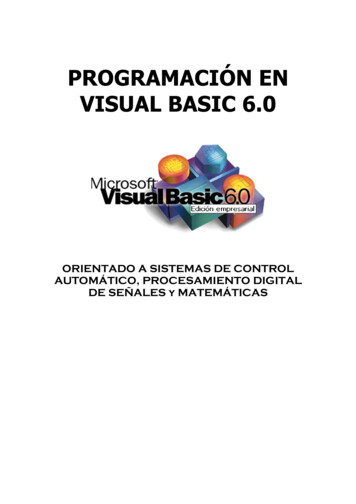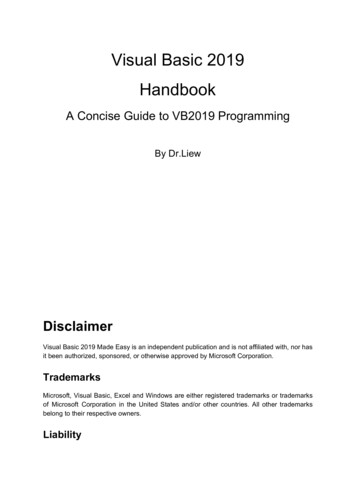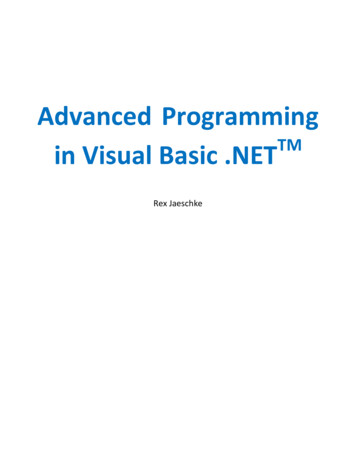
Transcription
Advanced ProgrammingTMin Visual Basic .NETRex Jaeschke
Advanced Programming in Visual Basic .NET 2002, 2009 Rex Jaeschke. All rights reserved.Edition: 2.0All rights reserved. No part of this publication may be reproduced, stored in a retrieval system, or transmitted inany form or by any means whatsoever, except in the case of brief quotations embodied in critical reviews andarticles.The information in this book is subject to change without notice and should not be construed as a commitment bythe author or the publisher. Although every precaution has been taken in the preparation of this book, the authorand the publisher assume no responsibility for errors or omissions.Java and JavaScript are trademarks of Sun Microsystems.NET, Visual Basic, Visual C#, Visual C , Visual Studio, and JScript are trademarks of Microsoft.The training materials associated with this book are available for license. Interested parties should contact theauthor at the address below.Please address comments, corrections, and questions to the author:Rex Jaeschke2051 Swans Neck WayReston, VA 20191-4023 1 (703) 860-0091 1 (703) 860-3008 (fax)www.RexJaeschke.comrex@RexJaeschke.comii 2002, 2009 Rex Jaeschke.
Table of ContentsPreface . vReader Assumptions . vPresentation Style . vExercises and Solutions . viThe Status of Visual Basic .NET . vi1. Threads. 11.1 Introduction . 11.2 Creating Threads . 21.3 Synchronized Statements . 51.4 Other Forms of Synchronization . 101.5 Managing Threads . 141.6 Thread-Local Storage . 151.7 Atomicity and Interlocked Operations . 172. Object Serialization . 212.1 Introduction . 212.2 Serializing Objects that Contain References . 242.3 Handling Multiple References . 262.4 Customized Serialization. 292.5 Identifying the Fields to be Serialized . 332.6 Serialization Format . 362.7 Type Packaging . 383. Sockets . 413.1 Introduction . 413.2 Server-Side Sockets. 413.3 Client-Side Sockets. 453.4 Serialization over Sockets . 484. Cloning Objects . 534.1 Copying by Constructor . 534.2 Class Cloning . 544.3 The Procedure Clone. 554.4 Using Object.MemberwiseClone . 564.5 Cloning Arrays . 594.6 Cloning and Derived Classes . 604.7 Creation without Construction . 625. Attributes . 655.1 Introduction . 655.2 Predefined .NET Attributes . 665.3 StructLayout and FieldOffset . 705.4 DllImport . 725.5 CLSCompliant . 755.6 Obsolete . 765.7 Custom Attributes. 77Annex A. Operator Precedence . 79Annex B. Visual Basic .NET Keywords . 83Index . 85 2002, 2009 Rex Jaeschke.iii
Advanced Programming in Visual Basic .NETiv 2002, 2009 Rex Jaeschke.
PrefacePrefaceThis text covers a number of more advanced Visual Basic .NET topics. The material is not hardware or operatingsystem-specific.Reader AssumptionsTo fully understand and exploit the material, you should be conversant with the following concepts and the syntaxrequired to express them in Visual Basic .NET: Basic Language ElementsLooping and TestingProceduresReferencesStrings and ArraysClassesInheritanceInterfacesException HandlingInput and OutputNamespacesPresentation StyleThe approach used in this book is different from that used in many other books and training courses. Havingdeveloped and delivered programming-language training courses for more than 15 years, I have found that thebest approach for my students is an incremental one. I avoid introducing things that are unnecessary at any giventime, thus making examples small, simple, and well focused. Specifically, I introduce the basic elements andconstructs of the language using procedural programming examples. Once those fundamentals have beenmastered, I move on to object-oriented concepts and syntax. Then follow the more advanced language and librarytopics. Many books on object-oriented languages use objects, inheritance, exception handling, GUI, andnumerous non-trivial library facilities in the first few examples, and certainly in the first chapter. I do not care forthis approach, either as a reader or as an educator. Instead, I prefer the student to have an excellent chance ofunderstanding and absorbing small amounts of new material, and reinforcing it with lab sessions, as theyprogress. The intent here is to eliminate any chance of their being overwhelmed, provided, of course, they meetthe prerequisites.Different styles work for different teachers and different students. I do not suggest that my approach is betterthan is any other; I simply know that my approach works well, and has formed the basis of my successful seminarbusiness for more than a decade. 2002, 2009 Rex Jaeschke.v
Advanced Programming in Visual Basic .NETExercises and SolutionsThe programs shown in the text are available electronically in a directory tree named Source, where eachchapter has its own subdirectory. By convention, the names of Visual Basic .NET source files end in “.vb”.Each chapter contains exercises, some of which have the character * following their number. For each exercise somarked, a solution is provided in a directory tree named Labs, in which each chapter has its own subdirectory.1Exercises that are not so marked have no general solution and require experimentation or research in animplementation's documentation. Exercises having solutions contain a statement of the form “(See labdirectory xx.)”, which indicates the corresponding solution or test file in the Labs subdirectory.You are strongly encouraged to solve all exercises in one section before continuing to the next. Also, invent yourown exercises as you go and be inquisitive; don't be afraid to experiment. Try to understand why the compilergives you each error or why a program fails at run time.The Status of Visual Basic .NETMicrosoft announced the Visual Basic .NET language and .NET platform in July 2000. At that time, Microsoft statedthat some subset of the library and runtime environment would be submitted for standardization, to EcmaInternational, a standards organization. In September 2000, Ecma committee TC39, which was responsible forstandardization of the scripting language ECMAScript (known commercially as JavaScript and JScript), agreed totake on this new work. As a result, TC39 was split into three Task Groups: TG1 (ECMAScript), TG2 (C#), and TG3(Common Library Infrastructure [CLI]). This author served as project editor of the standards produced by TG2 andTG3.The submission to Ecma was sponsored by Hewlett-Packard, Intel, and Microsoft. A number of other companiesalso agreed to participate in the standards work, which began in November 2000. That work was completed inSeptember 2001, and the CLI (and C#) standard was adopted by Ecma in December 2001. The standard for CLI isECMA-335. (This standard can be downloaded free of charge from www.ecma-international.org.)In January 2002, a 6-month review and ballot period began within ISO/IEC JTC 1 to determine if this specificationshould be adopted as an ISO/IEC standard as well. After a ballot-resolution meeting in September 2002, thisspecification was approved unanimously, and it was forwarded to ISO for publication. The designation of the CLIstandard is ISO/IEC 23271. (See www.iso.org.)A revision of the Ecma version of this standard started in January 2003, and was completed in March 2005. Ecmaadopted it in June 2005, and ISO/IEC JTC 1 adopted it in April 2006.In 2008, Ecma transferred the Task Groups TG2 (C#) and TG3 (CLI) from Technical Committee TC39 to TC49.The Visual Basic .NET language itself has not been standardized.Rex Jaeschke, September 20091The solutions are only available to licensees of these materials when they are used in formal training scenarios.vi 2002, 2009 Rex Jaeschke.
1. Threads1.ThreadsVisual Basic .NET supports the ability to create multiple threads of execution within a single application. In thischapter, we'll see how threads are created and synchronized.1 We'll also see how shared variables can be guardedagainst compromise during concurrent operations.1.1IntroductionA thread is an individual stream of execution as seen by the processor, and each thread has its own register andstack context. The run-time environment executes only one thread at a time. The execution of a thread isinterrupted when it needs resources that are not available, it is waiting for an operation such as an I/O tocomplete, or if it uses up its processor time slice. When the processor changes from executing one thread toanother, this is called context switching. By executing another thread when one thread becomes blocked, thesystem allows processor idle time to be reduced. This is called multitasking.When an application is executed, the system is told where on disk to get instructions and shared data. A set ofvirtual memory locations, collectively called an address space is allocated to that application, as are varioussystem resources. This runtime context is called a process. However, before a process can do any work, it musthave at least one thread. When each process is created, it is automatically given one thread, called the primarythread. However, this thread has no more capability than other threads created for that process; it just happenedto the first thread created for that process. The number of threads in a process can vary at runtime, underapplication control. Any thread can create other threads; however, a creating thread does not in any sense ownthe threads it creates; all threads in a process belong to the process as a whole.The work done by a process can be broken into subtasks with each being executed by a different thread. This iscalled multithreading. Each thread in a process shares the same address space and process resources. When thelast remaining thread in a process terminates, the parent process terminates.Why have more than one thread in a process? If a process has only one thread, it executes serially. When thethread is blocked, the system is idle if no other process has an active thread waiting. This may be unavoidable ifthe subtasks of the process must be performed serially; however, this is not the case with many processes.Consider a process that has multiple options. A user selects some option, which results in lots of computationsusing data in memory or a file and the generation of a report. By spawning off a new thread to perform this work,a process can continue accepting new requests for work without waiting for the previous option to complete. Andby specifying thread priorities, a process can allow less-critical threads to run only when more-critical threads areblocked.Once a thread has been dispatched, another thread can be used to service keyboard or mouse input. For example,the user might decide that a previous request is not the way to go after all, and wishes to abort the first thread.This can be done by selecting the appropriate option on a pull-down menu and having one thread stop the other.1It is important to note that Visual Basic .NET does not support synchronization of threads in different applications. 2002, 2009 Rex Jaeschke.1
Advanced Programming in Visual Basic .NETAnother example involves a print spooler. Its job is to keep a printer busy as much as possible and to service printrequests from users. The users would be very unhappy if the spooler waits until a job had completed printingbefore it started accepting new requests. Of course, it could periodically stop printing to see if any new requestswere pending (this is called polling), but that wastes time if there are no requests. And if the time intervalbetween polls is too long, there is a delay in servicing requests. If it is too short, the thread spends too much timepolling. Why not have the spooler have two threads: one to send work to the printer, the other to deal withrequests from users. Each runs independent of the other and when a thread runs out of work, it either terminatesitself or goes into an efficient state of hibernation.When dealing with concurrently executing threads, we must understand two important aspects: atomicity andreentrancy.An atomic variable or object is one that can be accessed as a whole even in the presence of asynchronousoperations that access the same variable or object. For example, if one thread is updating an atomic variable orobject while another thread reads its contents, the logical integrity of those contents cannot be compromised—the read will get either the old or the new value, never part of each. Normally, the only things that can beaccessed atomically are those having types supported atomically in hardware, such as bytes and words. All theprimitive types in Visual Basic .NET except Date, Decimal, Double and Long are guaranteed to be atomic.Clearly, a Point object is not atomic; it has two parts, an x- and a y-coordinate, and a writer of a Point's value couldbe interrupted by a reader to that Point, resulting in the reader getting the new x and old y, or vice-versa.Similarly, arrays cannot be accessed atomically. Since most objects cannot be accessed atomically, we must usesome form of synchronization to ensure that only one thread at a time can operate on certain objects. For thisreason, Visual Basic .NET assigns each object, array, and class a synchronization lock.A reentrant procedure is one that can safely be executed in parallel by multiple threads of execution. When athread begins executing a procedure, all data allocated in that procedure comes either from the stack or the heap.In any event, it's unique to that invocation. If another thread begins executing that same procedure while the firstthread is still working there, each thread's data will be kept separate. However, if that procedure accessesvariables or files that are shared between threads, it must use some form of synchronization.1.2Creating ThreadsIn the following example (see directory Th01), the primary thread creates two other threads, and the threethreads run in parallel without synchronization. No data is shared between the threads and the processterminates when the last thread terminates:Imports System.ThreadingPublic Class Th01Private loopStart As IntegerPrivate loopEnd As IntegerPrivate dispFrequency As Integer2 2002, 2009 Rex Jaeschke.
1. ThreadsPublic Sub New(ByVal startValue As Integer, ByVal endValue As Integer,ByVal frequency As Integer)loopStart startValueloopEnd endValuedispFrequency frequencyEnd Sub'1Public Sub ThreadEntryPoint()'2Dim threadName As String Thread.CurrentThread.NameDim i As Integer loopStartWhile i loopEndIf i Mod dispFrequency 0 ThenConsole.WriteLine("{0}: i {1,10}", threadName, i)End Ifi 1End WhileConsole.WriteLine("{0} thread terminating", threadName)End Sub]Public Shared Sub Main()'3aDim o1 As New Th01(0, 1000000, 200000)'3bDim t1 As New Thread(AddressOf o1.ThreadEntryPoint)'3ct1.Name "t1"'4aDim o2 As New Th01(-1000000, 0, 200000)'4bDim t2 As New Thread(AddressOf o2.ThreadEntryPoint)'4ct2.Name mary thread terminating")End SubEnd ClassLet's begin by looking at the first executable statement in the program, that in case 3a. Here we create an objecthaving the user-defined type Th01. That class has a constructor, an instance procedure, and three fields. We callthe constructor passing it a start and end count, and an increment amount, which it stores for later use incontrolling a loop. 2002, 2009 Rex Jaeschke.3
2. Object Serialization2.Object SerializationMost useful applications depend on information of a more permanent nature than that generated during a singleexecution. For example, applications that access an inventory, typically query (and possibly update) one of morerelated data files. The lives of such “master files” transcend that of the execution of any of the applications thatuse them. Other applications involve the communication of messages between separate applications, oftenreferred to as client and server. While the life of a message is often much shorter than that of a database record,both cases involve the use of some data format external to the applications that manipulate them.In this chapter, we'll see how Visual Basic .NET objects and variables of simple types can be converted into someexternal form suitable for use in file storage or for transmission during inter-application communication. Theprocess of converting to some external form is known as serialization while that of converting back again is knownas deserialization.2.1IntroductionConsider the following example (see directory Sr01) which writes a number of values of a variety of object andsimple types to a disk file, closes that file, and then reads those values back into memory again:Imports System.IOImports ic Module Sr01Public Sub Main()Dim intArray() As Integer {10, 20, 30Dim floatArray(,) As Single {{1.2F, 2.4F},{3.5F, 6.8F},{8.4F, 9.7F}}Dim dt As DateTime DateTime.NowConsole.WriteLine("dt {0} ", dt)'1Dim formatter As New BinaryFormatter()In case 1, we define a variable of type BinaryFormatter. Objects of this type allow the serialization anddeserialization of any object or an entire graph1 of connected objects in some binary format. (We'll see in §2.6how alternate formats can be used.)1The term graph as used here refers to a kind of nonlinear data structure. For example, an Employee type might contain aname field, which, in turn, is made up of a first name, an initial, and a last name. The type might also contain several dateobjects, representing date of birth, date of hire, and date of last review. The graph designated by a reference to an instanceto such a type involves all of that instance's dependent data tree starting at the root reference. 2002, 2009 Rex Jaeschke.21
Advanced Programming in Visual Basic .NET' Serialize data to a f.'2Dim f As Stream File.Open("Sr01.ser", FileMode.Create)'3aformatter.Serialize(f, "Hello")'3bformatter.Serialize(f, intArray)'3cformatter.Serialize(f, floatArray)'3dformatter.Serialize(f, True)'3eformatter.Serialize(f, dt)'3fformatter.Serialize(f, 1000)'3gformatter.Serialize(f, "X"c)'3hformatter.Serialize(f, 1.23456F)'4f.Close()In case 2, we create a new file having the name shown. The suffix “.ser” has no special meaning; it is simply a localconvention that signifies a serialized data file. Cases 3a through 3h each result in an object being serialized to thatfile. In the case of the string, each character is written. In the case of the arrays, all elements are written. In thecase of the DateTime, all data contained within that type and any associated dependencies are written. In thecase of the simply type values, they are first boxed and the corresponding Objects are written. So Serializeneed only be defined to accept an argument of type Object.' Deserialize data from a f.'5f File.Open("Sr01.ser", FileMode.Open)'6aDim s As String tring {0} ", s)We retrieve the serialized data by calling the procedure Deserialize, as shown in case 6a. Since that procedurereturns a value of type Object, we need to convert that to the appropriate type.22 2002, 2009 Rex Jaeschke.
2. Object Serialization'6bDim newIntArray() As Integer riteLine("newIntArray:")Dim i As Integer 0While i newIntArray.LengthConsole.Write(" {0}", newIntArray(i))i 1End WhileConsole.WriteLine()'6cDim newSingleArray(,) As Single CType(formatter.Deserialize(f), Single(,))Console.WriteLine("newSingleArray:")i 0While i 3Dim j As Integer 0While j 2Console.Write(" {0}", newSingleArray(i, j))j 1End WhileConsole.WriteLine()i 1End While'6dDim b As Boolean Boolean {0} ", b)'6eDim newDT As DateTime newDT {0} ", newDT)'6fDim v As Integer nteger {0} ", v)'6gDim c As Char Char {0} ", c)'6hDim sn As Single ingle {0} ", sn)'7f.Close()End SubEnd ModuleWhen executed on the date and time shown, the output produced is: 2002, 2009 Rex Jaeschke.23
4. Cloning Objects4.Cloning ObjectsUnlike most other languages, Visual Basic .NET provides no way to have an expression of some object type; thebest we can do is to have an expression whose value is really a reference to that type. As a result, Visual Basic.NET provides no linguistic way to copy an object. Assuming we can justify it, how then can we make a completecopy of an object?4.1Copying by ConstructorConsider the following code fragment (see directory Cn01):Public Class Point' .Public Sub New(ByVal xorigin As Integer, ByVal yorigin As Integer)X xoriginY yoriginEnd SubPublic Sub New(ByVal p As Point)X p.XY p.YEnd Sub' .End ClassThe constructor creates a new Point using the contents of an existing one. (In C , this kind of constructor is sospecial it has the name copy constructor; however, this term is not used in the context of Visual Basic .NET.)Public Module Cn01Public Sub Main()'1Dim p1 As New Point(3, 5)'2Console.WriteLine("p1: {0}", p1)'3Dim p2 As New Point(p1)'4p1.Move(9, 11)'5Console.WriteLine("p1: {0}", p1)'6Console.WriteLine("p2: {0}", p2)End SubEnd Module 2002, 2009 Rex Jaeschke.53
Advanced Programming in Visual Basic .NETPoint p2 is a copy of p1, so when the coordinate values of p1 are changed in case 4, we see from the followingoutput that those of p2 are not:p1: (3,5)p1: (9,11)p2: (3,5)While this approach works fine, we won't find standard library classes having this form of constructor, however.4.2Class CloningThose few standard library classes that do support some sort of copy mechanism achieve it by what is referred toas cloning. Consider the following example (see directory Cn02) that uses the library class ArrayList, a type thatsupports vectors:Imports System.CollectionsPublic Module Cn02Public Sub Main()Dim al1 As New "Green")al1.Add("Yellow")'2PrintEntries("al1", al1)'3Dim al2 As ArrayList CType(al1.Clone(), ArrayList)'4PrintEntries("al2", At(0)al1.Insert(0, "Brown")'6PrintEntries("al1", al1)'7PrintEntries("al2", al2)End Sub54 2002, 2009 Rex Jaeschke.
4. Cloning ObjectsPrivate Sub PrintEntries(ByVal s As String, ByVal aList As ArrayList)Console.Write("{0: ", s)Dim o As ObjectFor Each o In aListConsole.Write(vbTab "{0}", o)NextConsole.WriteLine()End SubEnd ModuleThe output produced ist al1 consists of a set of 4 strings specifying different colors. We then make a complete copy of thatobject in case 3 by calling the procedure ArrayList.Clone, so the output produced by cases 2 and 4 is thesame. Then we modify al1 by removing the second element, by adding a new element to the end, and bychanging the first element's value. When we compare the output produced by cases 6 and 7, we see that thechanges applied to al1 have no affect on al2. Specifically, the internal reference inside of al2 points to its ownprivate copy of elements, not to the same set as al1. This is referred to as a deep copy, whereas simply makingboth ArrayLists' internal reference point to the same set of values (as would be the case with the assignmental2 al1) is called a shallow copy.If we wish to make copies of our own objects, we would do well to model the copy process on the library cloningmachinery.4.3The Procedure CloneThe key to cloning is to implement the standard interface ICloneable, which, in turn, requires us to define aprocedure called Clone that takes no arguments and has a return type of Object. For example, consider thefollowing program fragment (see directory Cn03):Public Class PointImplements ICloneable'.Public Sub New(ByVal xorigin As Integer, ByVal yorigin As Integer)X xoriginY yoriginEnd Sub 2002, 2009 Rex Jaeschke.55
Advanced Programming in Visual Basic - Rex Jaeschke . and . }

